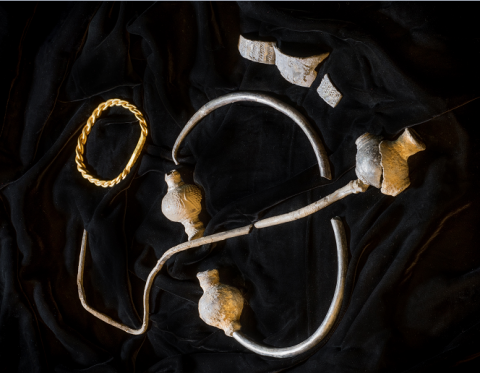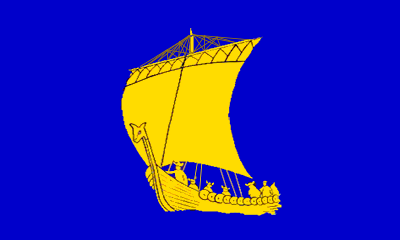Discovery in Isle of Man of Viking Treasure Hoard from 950 AD

An internationally significant find of Viking Age artefacts were declared as Treasure by the appropriate authority in the Isle of Man (Manx Gaelic: Mannin) today (February 18th 2021). They were discovered in late 2020 by metal detectorist Kath Giles whilst metal detecting on private land. The Treasure is of international significance and consists of a gold arm-ring, a massive silver brooch, at least one silver armband and other associated finds. They were buried around AD 950.
Allison Fox, Curator for Archaeology for Manx National Heritage (Manx: Eiraght Ashoonagh Vannin) said: “The arm-ring is a rare find. Gold items were not very common during the Viking Age. Silver was by far the more common metal for trading and displaying wealth. It has been estimated that gold was worth 10 times the value of silver and that this arm-ring could have been the equivalent of 900 silver coins”. As reported on the Manx National Heritage website the hoard will go on display in the Viking and Medieval Gallery at the Manx Museum (Manx: Thie Tashtee Vannin) on Thursday 18 February prior to valuation and further conservation work.
The influences of the Norse remains strong in the Celtic lands with coastlines on the Western Atlantic and the Irish Sea. They are clear in the names of people, place names, customs and archaeology. Even in political institutions such as the parliament of the Isle of Man Tynwald (Manx: Tinvaal). The name is derived from the Norse ‘Thingvalla’ which means ‘Assembly Place’. The Manx have retained the system of government introduced by the Norse and Tynwald is said to be the oldest continuous parliament in the world.
The Viking interventions began in the 8th century AD, firstly trading and eventually settling. The Islands of Scotland and the Isle of Man formed the Northern and Southern Isles. The Northern Isles of Shetland and Orkney were known to the Norse as Norðreyjar. The Southern Isles forming the Kingdom of Mann and the Isles (sometimes known as The Kingdom of the Isles) consisting of the Hebrides, the islands in the Firth of Clyde and the Isle of Man were known as Suðreyjar. Scandinavian influences did however, have some impact on all of what are now described as the modern Celtic Nations.
Norse settlers into the Gaelic lands adopted Gaelic culture and language and intermarried with indigenous Gaels. Over time these Norse–Gaels became increasingly Gaelicised and merged into that community. However, Gaelicised Scandinavians dominated the region of the Irish Sea for a number centuries. The Norse also had a significant impact in Ireland and established independent kingdoms in Dublin, Waterford, Wexford, Cork and Limerick.
Even as the Norse and Viking influence weakened in the lands that surrounded the Isle of Man their influence remained strong on the Island for many years. The Treaty of Perth, signed between Scotland and Norway on 2 July 1266 is often given as the end of Norse rule of the Isle of Man. However, Scotland's rule over Mann did not become firmly established till 1275, when the Manx suffered defeat in the decisive Battle of Ronaldsway, near Castletown. It was then that the final attempt by the Manx to re-establish the Norse Suðreyjar dynasty came to an end. The battle resulted in the death of the last Norse King of Mann, Guðrøðr Magnússon, and the emigration to Norway of the remaining members of the Manx royal family.
Image above: Courtesy of Manx National Heritage Viking Age artefacts discovered on the Isle of Man.
Image below: Flag of Manx Parliament Tynwald.







